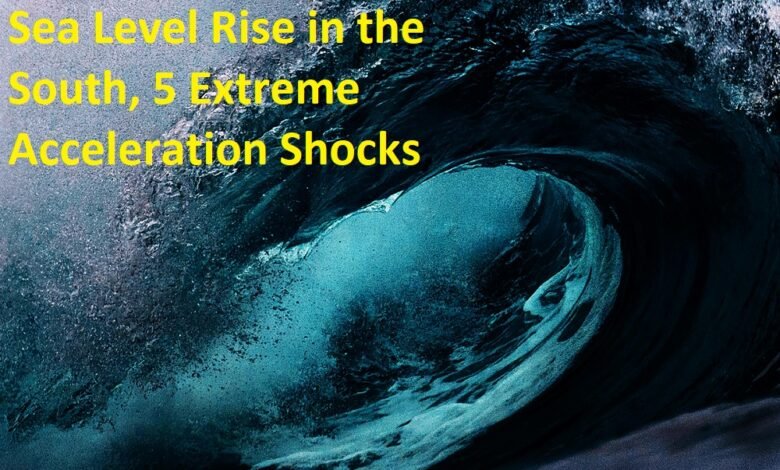Sea Level Rise in the South: 5 Extreme Acceleration Shocks, Scientists Alarmed

Introduction: Sea Level Rise
Recently, the problem of sea level rise has emerged as a significant problem, in some areas of the Southern regions of the United States. The rise in the sea level for these regions is one of the fastest seen globally, and this has come as a shocker to researchers, and poses a perill for the coastal residents, species, and countries’ economic stability. This article contains descriptive information about the five extreme shock waves of sea level rise in the South along with scientific backing along with their impact.
Table of Contents
- 1. Introduction
- 2. The Reality of Sea Level Rise
- 3. Extreme Acceleration Shocks: The Five Key Points
- – Accelerated Rise in the Gulf of Mexico
- – Impact on Coastal Communities
- – Threats to Wildlife and Habitats
- – Amplifying Hurricane Storm Surges
- – Long-term Economic Consequences
- 4. Scientific Research and Findings
- – NOAA’s Alarming Data
- – Neolithic Comparisons and Historical Context
- 5. Global Implications and Comparisons
- 6. Reactions and Policies
- – Government Responses
- – Community Initiatives
- 7. The Future: Mitigation and Adaptation Strategies
- 8. Conclusion
The Reality of Sea Level Rise
It is a global process mainly caused by climate change with an addition to the thermal expansion of the sea and the melting of the glacial volumes. Nonetheless, the rate differs based on regions mainly because of the affect of ocean currents, the degree of subsidence of territories, as well as regional climate. Scientists and policymakers get concerned because in the Southern United States the rate of sea level rises has increased significantly.
Understanding Sea Level Rise
Basic Knowledge
| Concept | Description |
| Definition | Sea level rise refers to the increasing level of the world’s oceans due to the melting of ice and thermal expansion caused by global warming. |
| Causes | Primarily caused by the melting of glaciers and ice sheets and the thermal expansion of seawater as it warms. |
| Measurements | Sea level is measured using tide gauges and satellite altimeters. |
Advanced Knowledge
| Concept | Description |
| Thermal Expansion | As water heats up, it expands. This is a significant contributor to sea level rise. |
| Ice Melt | Melting of ice sheets in Greenland and Antarctica significantly contributes to rising sea levels. |
| Regional Variations | Sea level rise is not uniform across the globe; some areas experience more rapid increases than others due to factors like ocean currents and land subsidence. |
Extreme Acceleration Shocks: The Five Key Points
Accelerated Rise in the Gulf of Mexico
It is still important to establish that many regions that neighbors the Gulf of Mexico are experiencing some of the fastest rates of sea level fluctuations. Per data obtained from NOAA, the region has been noted to have risen by about six inches in the past twenty years; that is almost three times the global rate. This acceleration it is caused through a number of factors such as thermal expansion, land gradient additional to subsidence and alterations flowing circulation in the ocean.
Impact on Coastal Communities
Again the coastal communities in the South are the hardest-hit because of the enhanced rates of sea level change. Cities like Miami, New Orleans, and Galveston are more likely to experience frequent floods even when it is high tide. There has been the emergence of the so-called sunny day flooding which interferes with people’s lives, affects buildings, and requires expensive solutions. Such effects are even worse during calamities and this is why there is need for structures that can endure such calamities.
Threats to Wildlife and Habitats
So, the accelerated increase in the levels of the sea does not only pose a threat to people but is also dangerous for animals and their environment. Those habitats, which include coastal wetlands, mangroves, and estuaries that catalyse biodiversity, are getting flooded at an alarming rate. This loss of habitat endanger the species that depend on these areas such as the migrating birds, fish and the invertebrates. , many species are likely to be lost in the Southern United States region which is well endowed with different species owing to the modern trends.
Amplifying Hurricane Storm Surges
Among the consequences that can be expected when a higher rate of sea level rises, the worsening of the storm surge phenomenon related to hurricanes is considered one of the most worrying. In addition, more intense storms contribute to increased sea levels; therefore, storm surges penetrate more deeply and cause more extensive flooding and losses. An area of the country particularly at risk is the area of the Southern United States, which is often affected by hurricanes. As recent hurricanes, for example, harvey and ida shows, the storm-surge together with the storm-surge heightened by sea level rise, raises threat levels and causes multiple-fatality hydrogen bomb-like devastating floods.
Long-term Economic Consequences
Evaluating economic consequences of sea level rise in the South is rather telling. Residential structures along coastlines are exposed with more than $300 billion of buildings vulnerable to be rendered unliveable or expensive to make flood-safe. One of the most important industries in many Southern states of America is tourism where beach erosion and damages to infrastructures are also starting to appear. Besides, industries involved in fishing, important sources of income in many coastal areas, also have issues, because the environment of such species as commercial fish is altered.
Scientific Research and Findings
NOAA’s Alarming Data
Several government departments dealing with natural resources have been in the forefront in monitoring the rising sea level and its effects among them is the National Oceanic and Atmospheric Administration (NOAA). Their data state that the rate of acceleration in the Southern States of the United States is amongst the highest globally. Based on the NOAA’s tide gauge measurements as well as satellite data, the authors have presented trends According to which the rate of rise has accelerated and has almost doubled within the time span of ten years alone. This data also substantiates the why and how of dealing with causes and preventing the effects of this occurrence (sea level rise).
Table: Observations and Impacts of Sea Level Rise
| Observation | Impact |
| Rapid Glacial Melt | Increased water volume in oceans |
| Thermal Expansion of Oceans | Rising sea levels due to water expansion |
| Submerged Coastal Lands | Higher risk of flooding and land loss |
| Increased Frequency of Storm Surges | Severe impacts on coastal infrastructure and safety |
| Rising Sea Levels Impacting Ecosystems | Disruption of habitats and loss of biodiversity |
Neolithic Comparisons and Historical Context
It is useful to compare today’s tendencies to the parameters of sea levels of other epochs, for example, Neolithic. In the Neolithic period, the level of the World Ocean did not go up and down a lot and the human settlements were placed along coastal areas. The currents and fast occurrences at present are undeniably the fastest in the history of mankind due to increasing anthropogenic effects including those from greenhouse gases. This historical view is meant to draw awareness to the current state of matters and the exigency of the circumstances.
Global Implications and Comparisons
Understanding sea level changes in the Southern United States implicates the global scenario in many ways. It is a very clear illustration of what we are likely to experience and see more of regarding the resulting effects of climate change and the interaction of global systems. The same can be attributed to the situations in other continents like the South-east Asia and the Pacific Islands where cases of floods and rising tides are likely to engulf entire communities. By comparing these regions it is easier to explain the overall picture of the extend of this issue at the international level and the necessity for the international collaboration.
Reactions and Policies
Government Responses
These forcing factors and threats are already known to governments at federal, state, and local levels and efforts are being made to undertake mitigation. Programs such as the Coastal Resilience Grants program which seeks to identify viable projects which could be funded for purpose of increasing the coastal community resilience. Also, reflecting on such disasters, new codes of structures and zoning ordinances are being put in place to minimize exposure to flood danger. However, more general and actively oriented measures are required to prevent the adverse effects in the long term efficiently.
Community Initiatives
Southerners are not passive and are not waiting for decisions to be made: several communities are proactively protecting themselves. Loddon of Cause related organization of the great communicants that are calling to spearhead practices like wetland restoration and green infrastructure. Awareness campaigns are also critical since residents will also need to be informed on likely risks and what they should expect it the future. Such initiatives are a key in the development of community resilience and enhancement of an adaptive culture among the people.
The Future: Mitigation and Adaptation Strategies
When planning for the future, it is evident that there is a need to reduce emission and prepare for the impacts of climate change. Greenhouse gases emissions need to be lowered in order to slow the volume of sea level increases, and there is a need to implement protective strategies which include constructing sea walls, raising the structures and the restoration of natural barriers. The development as well as the implementation of these strategies shall involve the governments, scientists, and communities.
Conclusion
Faster trends of sea level increase in the Southern region of United States is a problem that requires attention. It therefore points out that the effects on coastal inhabitants, fauna, and revenues are already colossal and they are bound to become worse. In turn, analysis of the scientific evidence and historical background, along with bringing together the world’s efforts to combat this challenge, will allow one to be ready for it and respond. From individual political measures, local and global community actions, and networking, it is possible to lessen the effects and strengthen the foundation for the future.
Table: Impacts and Solutions of Accelerated Sea Level Rise
| Impact | Description | Potential Solution |
| Increased Hurricane Surges | Higher sea levels amplify the impact of storm surges | Enhanced coastal defenses, early warning systems |
| Rapid Coastal Erosion | Accelerated erosion threatens infrastructure and habitats | Restoration of natural barriers, building regulations |
| Flooding of Low-Lying Areas | Frequent flooding in low-lying areas causing damage and disruption | Sustainable urban planning, flood management systems |
| Threat to Biodiversity | Loss of coastal ecosystems impacting species and ecological balance | Conservation efforts, habitat restoration |
| Impact on Human Habitation | Displacement of communities and socio-economic challenges | Community relocation plans, economic support programs |




Your article helped me a lot, is there any more related content? Thanks!